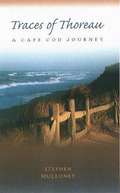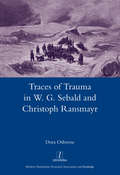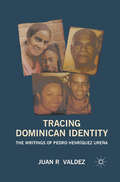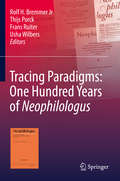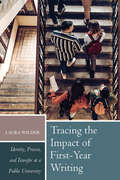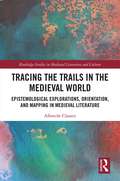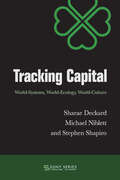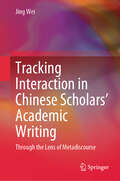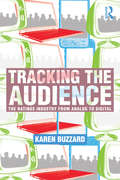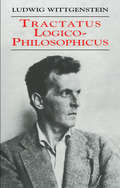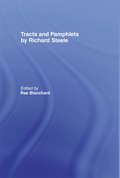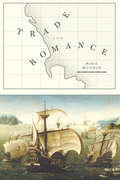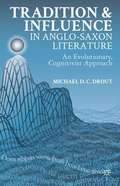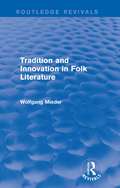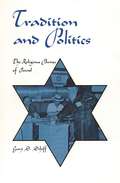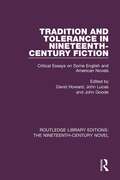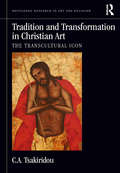- Table View
- List View
Traces of Thoreau: A Cape Cod Journey
by Stephen MulloneyThe contemporary companion to Henry David Thoreau's classic Cape Cod.
Traces of Trauma in W. G. Sebald and Christoph Ransmayr
by Dora Osborne"Both W. G. Sebald (1944-2001) and the Austrian author Christoph Ransmayr (1954-) were born too late to know directly the violence of the Second World War and the Holocaust, but these traumatic events are a persistent presence in their work. In a series of close readings of key prose texts, Dora Osborne examines the different ways in which the traces of a traumatic past mark their narratives. By focusing on the authors' use of visual and topographical tropes, she shows how blind spots and inhospitable places configure signs of past violence, but, ultimately, resist our understanding. Whilst links between the two authors are well-documented, this book offers the first full-length study of Sebald and Ransmayr and their complicated relation to the traumatic traces of National Socialism. Dora Osborne is Lecturer in German at the University of Nottingham."
Tracing Dominican Identity
by Juan R. ValdezThe author analyzes and discusses the socio-historical meanings and implications of Pedro Henríquez Ureña's (1884-1946) writings on language. This important twentieth century Latin American intellectual is an unavoidable reference in Hispanic Linguistics and Cultural Studies.
Tracing Paradigms: One Hundred Years of Neophilologus
by Rolf H. Bremmer Jr Thijs Porck Frans Ruiter Usha WilbersThis volume brings together a selection of pivotal articles published in the hundred years since the launch of the journal Neophilologus. Each article is accompanied by an up-to-date commentary written by former and current editors of the journal. The commentaries position the articles within the history of the journal in particular and within the field of Modern Language Studies in general. As such, this book not only outlines the history of a scholarly journal, but also the history of an entire field. Over the course of its first one hundred years, 1916 to 2016, Neophilologus: An International Journal of Modern and Mediaeval Language and Literature has developed from a modest quarterly set up by a group of young and ambitious Dutch professors as a platform for their own publications to one of the leading international journals in Modern Language Studies. Although Neophilologus has remained broad-scope, multilingual and multidisciplinary, it has witnessed dramatic changes in its long-standing history: paradigm shifts, the rise and fall of literary theories, methods and sub-disciplines, as has the field of Modern Language Studies itself.
Tracing War in British Enlightenment and Romantic Culture (Palgrave Studies in the Enlightenment, Romanticism and Cultures of Print)
by Gillian Russell Neil RamseyThis volume argues for the enduring and pervasive significance of war in the formation of British Enlightenment and Romantic culture. Showing how war throws into question conventional disciplinary parameters and periodization, essays in the collection consider how war shapes culture through its multiple, divergent, and productive traces.
Tracing Women's Romanticism: Gender, History, and Transcendence (Routledge Studies in Romanticism #Vol. 4)
by Kari E. LokkeAwarded the 2005 Jean-Pierre Barricelli Book Prize by the International Conference on Romanticism This book explores a cosmopolitan tradition of nineteenth-century novels written in response to Germaine de Staël's originary novel of the artist as heroine, corinne. The first book to delineate the contours of an international women's Romanticism, it argues that the künstlerromane of Mary Shelley, Bettine von Arnim, and George Sand offer feminist understandings of history and transcendence that constitute a critique of Romanticism from within. The book examines meditative, mystical and utopian visions of religious and artistic transcendence in the novels of women Romanticists as vehicles for the representation of a gendered subjectivity that seeks detachment and distance from the interests and strictures of the existing patriarchal social and cultural order. For these writers, the author argues, self-transcendence means an abandonment or dissolution of the individual self through political and spiritual efforts that culminate in a revelation of the divinity of a collective selfhood that comes into being through historical process.
Tracing the Connected Narrative
by Janice CavellBy the 1850s, journalists and readers alike perceived Britain's search for the Northwest Passage as an ongoing story in the literary sense. Because this 'story' appeared, like so many nineteenth-century novels, in a series of installments in periodicals and reviews, it gained an appeal similar to that of fiction. Tracing the Connected Narrative examines written representations of nineteenth-century British expeditions to the Canadian Arctic. It places Arctic narratives in the broader context of the print culture of their time, especially periodical literature, which played an important role in shaping the public's understanding of Arctic exploration.Janice Cavell uncovers similarities between the presentation of exploration reports in periodicals and the serialized fiction that, she argues, predisposed readers to take an interest in the prolonged quest for the Northwest Passage. Cavell examines the same parallel in relation to the famous disappearance and subsequent search for the Franklin expedition. After the fate of Sir John Franklin had finally been revealed, the Illustrated London News printed a list of earlier articles on the missing expedition, suggesting that the public might wish to re-read them in order to 'trace the connected narrative' of this chapter in the Arctic story. Through extensive research and reference to new archival material, Cavell undertakes this task and, in the process, recaptures and examines the experience of nineteenth-century readers.
Tracing the Impact of First-Year Writing: Identity, Process, and Transfer at a Public University
by Laura WilderTracing the Impact of First-Year Writing presents the results of a large-scale longitudinal study of college writers that explores the impact of a required first-year writing course with a comparative approach not previously available. Over five years Laura Wilder conducted 143 interviews with, and collected 774 pages of writing from, 58 students, half of whom had taken a new first-year writing course and half who had not. Wilder found that while in many ways the experiences of both groups are comparable—demonstrating how students receive valuable educations in rhetoric and writing from a variety of sources beyond a first-year writing course—students who took the first-year writing course were much more likely to identify as writers. This identification supported students’ use of writing in powerfully generative and knowledge-building ways that they carried with them long after the course into other appropriate contexts. In contrast to previous longitudinal studies of college writers undertaken at institutions with high prestige and resources, Tracing the Impact of First-Year Writing explores the role of writing at a regional public university and documents how students’ experiences with writing can be highly divergent across the curriculum and unequal across campuses. Additionally, this book includes the voices of students who do not identify as capable writers and have strongly negative emotional reactions to writing and writing instruction and adds empirical support to innovative calls in the field to transform the first-year writing course into one that inspires students to reflectively consider writing itself.
Tracing the Origins: Studying the Lineage of Indiana University’s Martial Arts Program
by Thomas GreenwoodTracing the Origins is a book in three parts. The first is a personal history of the author as it relates to martial arts. The second is an ethnographical study of the authors martial lineage and more importantly the ways in which lineage functions. Lastly are the transcriptions of the interviews the author conducted in pursuit of this work. Tracing the Origins should prove especially interesting to those interested in the field of ethnography as it relates to martial arts and lineage.
Tracing the Trails in the Medieval World: Epistemological Explorations, Orientation, and Mapping in Medieval Literature
by Albrecht ClassenEvery human being knows that we are walking through life following trails, whether we are aware of them or not. Medieval poets, from the anonymous composer of Beowulf to Marie de France, Hartmann von Aue, Gottfried von Strassburg, and Guillaume de Lorris to Petrarch and Heinrich Kaufringer, predicated their works on the notion of the trail and elaborated on its epistemological function. We can grasp here an essential concept that determines much of medieval and early modern European literature and philosophy, addressing the direction which all protagonists pursue, as powerfully illustrated also by the anonymous poets of Herzog Ernst and Sir Gawain and the Green Knight. Dante’s Divina Commedia, in fact, proves to be one of the most explicit poetic manifestations of the fundamental idea of the trail, but we find strong parallels also in powerful contemporary works such as Guillaume de Deguileville’s Pèlerinage de la vie humaine and in many mystical tracts.
Track Changes: A Literary History of Word Processing
by Matthew G. KirschenbaumWriting in the digital age has been as messy as the inky rags in Gutenberg's shop or the molten lead of a Linotype machine. Matthew Kirschenbaum examines how creative authorship came to coexist with the computer revolution. Who were the early adopters, and what made others anxious? Was word processing just a better typewriter, or something more?
Tracking Capital: World-Systems, World-Ecology, World-Culture (SUNY series, Literature . . . in Theory)
by Stephen Shapiro Sharae Deckard Michael NiblettTracking Capital introduces new ways to understand the entanglement of cultural forms and practices in economic, social, and ecological crises and struggles. Building on the fundamental insights of world-systems analysis, the book offers readers a series of rubrics, keywords, and concepts—such as zemiperiphery, registration, and commodity chains—to enable more integrated, transdisciplinary methods of literary and cultural study. Throughout, Sharae Deckard, Michael Niblett, and Stephen Shapiro foreground the role of culture in both consolidating and contesting the classism, racism, sexism, and ecocide constitutive of the modern world-system. In the context of capitalism's ongoing bloody war against the poor, the powerless, and the planet, Tracking Capital provides tools with which to diagnose the morbid symptoms of the present, as well as to plot possible steps on the road to a better future.
Tracking Interaction in Chinese Scholars’ Academic Writing: Through the Lens of Metadiscourse
by Jing WeiThis book tracks changes in the use of metadiscourse in Chinese scholars’ English and Chinese research articles, discusses how these changes reflect changes in Chinese scholars’ interactions with their peers in China and outside China, and analyzes how Chinese scholars are responding to changes in the academic context that embrace and shape rhetorical practices in the academic world. Around the turn of the twenty-first century, the Chinese government declared the goal of “enhancing international soft power,” and one important way to achieve this goal is to promote China’s global academic influence. China has indeed made remarkable strides in terms of academic output by publishing Chinese scholars’ research papers and monographs around the world. However, “international soft power” means more than just the export of papers or books; it means connecting to and participating in the academic world. For this to happen, Chinese scholars must get to know their international counterparts, understand their rhetorical preferences, and be willing (and able) to accommodate their needs.
Tracking the Audience: The Ratings Industry From Analog to Digital
by Karen BuzzardIn Tracking the Audience: The Ratings Industry From Analog to Digital, author Karen Buzzard examines the key economic, political, and competitive factors that have influenced ratings methods dominant in each of the markets for radio, TV, and the Internet, tracing the practice¹s history from its early beginnings up to its most recent advances. Beginning with the birth of the industry in 1929, Tracking the Audience traces the establishment of a standardized ratings "currency" as it evolved to meet the needs of the analog broadcast system, and explores the search for new gold standards necessitated by the devastating effects of the digital revolution. Buzzard examines key challenges to the established system by discussing the movement from traditional sampling methods to new, more transparent measurements. More than a history of the ratings industry itself, it also tracks the evolving business model for the broadcast industry. Tracking the Audience: The Ratings Industry From Analog to Digital shows how the development of conceptual tools designed to measure and package radio, TV, and Internet audiences is the result of a variety of historical factors. With a detailed examination of ratings providers, their methods, and their attempts to adjust to meet new demands a digital age, this volume explains how a standardized broadcast system of audience measurement ratings has evolved, and where it is going in the future.
Tractatus Logico-Philosophicus (Barnes And Noble Library Of Essential Reading #Vol. 4447)
by Ludwig Wittgenstein"Philosophy is not a theory," asserted Austro-British philosopher Ludwig Wittgenstein (1889–1951), "but an activity." In this 1921 opus, his only philosophical work published during his lifetime, Wittgenstein defined the object of philosophy as the logical clarification of thoughts and proposed the solution to most philosophic problems by means of a critical method of linguistic analysis. In proclaiming philosophy as a matter of logic rather than of metaphysics, Wittgenstein created a sensation among intellectual circles that influenced the development of logical positivism and changed the direction of 20th-century thought.Beginning with the principles of symbolism and the necessary relations between words and objects, the author applies his theories to various branches of traditional philosophy, illustrating how mistakes arise from inappropriate use of symbolism and misuses of language. After examining the logical structure of propositions and the nature of logical inference, he discusses the theory of knowledge as well as principles of physics and ethics and aspects of the mystical.Supervised by the author himself, this translation from the German by C. K. Ogden is regarded as the definitive text. A magisterial introduction by the distinguished philosopher Bertrand Russell hails Wittgenstein's achievement as extraordinarily important, "one which no serious philosopher can afford to neglect." Introduction by Bertrand Russell.
Tractatus Logico-Philosophicus: The New Translation (Routledge Classics Ser.)
by Ludwig WittgensteinWidely regarded as one of the most influential philosophical works of the twentieth century, Ludwig Wittgenstein's Tractatus Logico-Philosophicus is a succinct yet wide-ranging exploration of language and logic, science and mysticism, which has inspired generations of thinkers, artists and poets. In a series of short, bold statements, Wittgenstein seeks to define the limits of language, its relation to logic, its power and its inherent failings. Originally published in the early 1920s, it is the only book-length work the renowned philosopher published in his lifetime.In this thrilling new translation, Alexander Booth displays an extraordinary sensitivity to the subtle influence on Wittgenstein's gem-like prose - at once specialist and, often, remarkably plain-spoken - of his background in mechanical engineering, while highlighting the underlying poetry of this seminal text.
Tractatus Logico-philosophicus (SparkNotes Philosophy Guide)
by SparkNotesTractatus Logico-philosophicus (SparkNotes Philosophy Guide) Making the reading experience fun! SparkNotes Philosophy Guides are one-stop guides to the great works of philosophy–masterpieces that stand at the foundations of Western thought. Inside each Philosophy Guide you&’ll find insightful overviews of great philosophical works of the Western world.
Tracts and Pamphlets by Richard Steele
by Rae BlanchardFirst Published in 1968. Sir Richard Steele's plays and major periodicals have been reprinted in modern times. But the miscellaneous tracts and pamphlets, which in his own day in the eighteenth century, ran into many editions and made his name famous, must now be sought out in antiquarian book shops and, one here, one there, in university libraries. To bring them all together for rereading is the purpose of this collected edition.
Trade and Romance
by Michael MurrinIn Trade and Romance, Michael Murrin examines the complex relations between the expansion of trade in Asia and the production of heroic romance in Europe from the second half of the thirteenth century through the late seventeenth century. He shows how these tales of romance, ostensibly meant for the aristocracy, were important to the growing mercantile class as a way to gauge their own experiences in traveling to and trading in these exotic locales. Murrin also looks at the role that growing knowledge of geography played in the writing of the creative literature of the period, tracking how accurate, or inaccurate, these writers were in depicting far-flung destinations, from Iran and the Caspian Sea all the way to the Pacific. With reference to an impressive range of major works in several languages—including the works of Marco Polo, Geoffrey Chaucer, Matteo Maria Boiardo, Luís de Camões, Fernão Mendes Pinto, Edmund Spenser, John Milton, and more—Murrin tracks numerous accounts by traders and merchants through the literature, first on the Silk Road, beginning in the mid-thirteenth century; then on the water route to India, Japan, and China via the Cape of Good Hope; and, finally, the overland route through Siberia to Beijing. All of these routes, originally used to exchange commodities, quickly became paths to knowledge as well, enabling information to pass, if sometimes vaguely and intermittently, between Europe and the Far East. These new tales of distant shores fired the imagination of Europe and made their way, with surprising accuracy, as Murrin shows, into the poetry of the period.
Tradition and Influence in Anglo-Saxon Literature: An Evolutionary, Cognitivist Approach
by Michael D. C. DroutThis book introduces lexomics, the use of computer-aided statistical analysis of vocabulary, to measure influence and integrate research from cognitive psychology and evolutionary biology with traditional, philological approaches to literature. Connecting the theory of tradition with the phenomenon of influence, Drout moves beyond current theories.
Tradition and Innovation in Folk Literature (Routledge Revivals)
by Wolfgang MiederIn this book, first published in 1987, Wolfgang Mieder follows the intriguing trail of some of the best known pieces of folk literature, tracing them from their roots to modern uses in advertising, journalism, politics, cartoons, and poetry. He reveals both the remarkable adaptability of these tales and how each variation reflects cultural and historical changes. Fairy tales, legends, folk songs, riddles, nursery rhymes, and proverbs are passed from generation to generation, changing both in form and meaning with each use. This book will be of interest to students of literature.
Tradition and Romanticism: Studies in English Poetry from Chaucer to W. B. Yeats (Routledge Library Editions: Romanticism #8)
by B. Ifor EvansFirst published in 1940. This title examines the tradition of Romantic literature, and the conception of poetry held by poets and critics throughout the centuries. Evans explores the writings of Chaucer, Shakespeare, Wordsworth and Coleridge, up until the modernist movement and the works of W. B. Yeats and T. S. Eliot. This title will be of interest to students of literature.
Tradition and Tolerance in Nineteenth Century Fiction: Critical Essays on Some English and American Novels (Routledge Library Editions: The Nineteenth-Century Novel #20)
by David Howard, John Lucas and John GoodeFirst published in 1966, this book collects six essays which discuss the experience of social change as it reveals itself in the work of several nineteenth century novelists. In the novels studied, and the discussion of fiction that follows, the authors argue that all these novelists’ attempts to confront social change — to connect old with new, past with present and the attempted inclusiveness of vision in a changing society — sooner or later fail. The essays are polemic in arguing against the contemporary critical consensus that this failure is a limitation of imaginative intelligence rather than an endorsement of a receding past which the process of change was charged with destroying.
Tradition and Transformation in Christian Art: The Transcultural Icon (Routledge Research in Art and Religion)
by C.A. TsakiridouTradition and Transformation in Christian Art approaches tradition and transculturality in religious art from an Orthodox perspective that defines tradition as a dynamic field of exchanges and synergies between iconographic types and their variants. Relying on a new ontology of iconographic types, it explores one of the most significant ascetical and eschatological Christian images, the King of Glory (Man of Sorrows). This icon of the dead-living Christ originated in Byzantium, migrated west, and was promoted in the New World by Franciscan and Dominican missions. Themes include tensions between Byzantine and Latin spiritualities of penance and salvation, the participation of the body and gender in deification, and the theological plasticity of the Christian imaginary. Primitivist tendencies in Christian eschatology and modernism place avant-garde interest in New Mexican santos and Greek icons in tradition.
